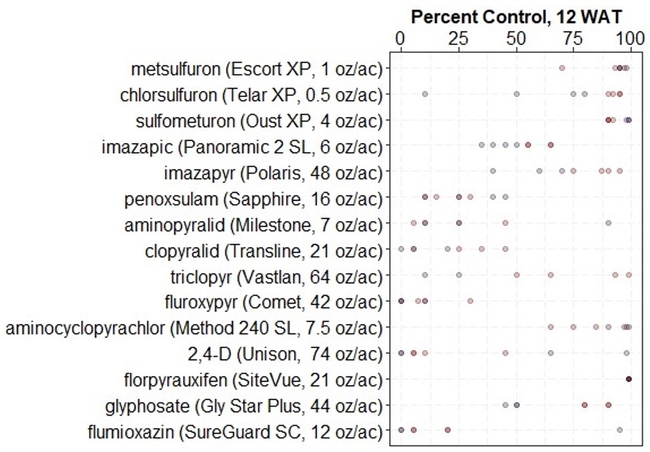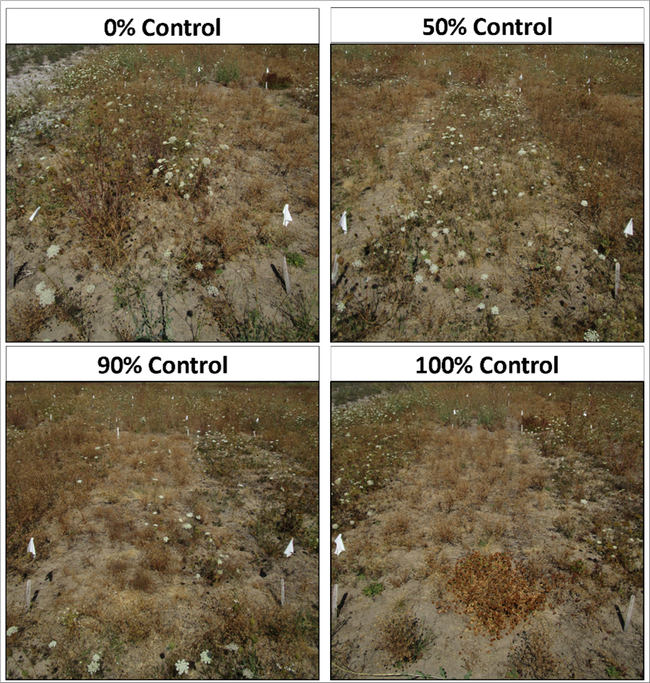Wild carrot, or Queen Anne's lace, is a widespread and difficult to control nuisance weed across most of western Oregon. It is prolific in roadsides, poorly managed pastures, post-harvest forestry sites, and other areas with intermediate disturbance levels, although it is adaptable enough to become weedy in many other sites as well. East of the Cascades, distribution is more sporadic, although there are certainly areas with dense populations. Wild carrot poses a potential contamination risk to carrot seed production, and is a high priority weed in wildlands and other extensively managed land uses surrounding current carrot seed production areas.
Despite its wide distribution, I was able to find surprisingly little public information regarding the efficacy of many herbicides currently important in non-crop settings for control of wild carrot. As part of a larger project focusing on proactively managing wild carrot risk around Oregon carrot seed production areas (funded by the Oregon Department of Agriculture Specialty Crop Block Grant Program), trials were initiated in the spring of 2022 at 2 non-crop sites in the Willamette Valley with the intent of providing weed managers with a straightforward comparison of the efficacy of common non-crop herbicide options for control of wild carrot.
Final data from these trials are not yet available and they will be repeated in 2024, but preliminary results show marked differences in efficacy between products. In both trials, herbicides (Figure 1) were applied to wild carrot plants in the rosette stage shortly after resumption of active spring growth in mid-March. Control was rated on a 0 to 100% scale at intervals throughout the season, with no plant damage at 0 and complete plant death at 100. Figure 1 shows raw control data at 12 weeks after treatment (WAT) for 4 replicate plots of each treatment at each of 2 trial locations (site 1 in red tones, site 2 in grey).
Summary data are presented at 12 WAT, but overall trends remained quite consistent for the remainder of the growing season. A few overall impressions emerge rather clearly to me, including:
- Wild carrot is difficult to control with many of the standby products widely used in non-crop sites. Those that have dealt extensively with wild carrot will likely have anticipated this, but I was still honestly surprised at just how poorly many of these herbicides performed on wild carrot.
- Fortunately, a few products do stand out as highly effective for wild carrot control. The new active ingredient florpyrauxifen (found alone in SiteVue, but likely more broadly applicable in DuraCor and HighNoon herbicides) was extremely effective on emerged wild carrot, and also provided soil residual control of late-germinating seedlings. If wild carrot control from a single application is critical, a product including florpyrauxifen should be top of list. The older active ingredients metsulfuron (e.g.Escort XP) and sulfometuron (Oust XP) were also quite effective both pre- and post-emergence. In the same mode of action, chlorsulfuron (e.g. Telar XP) also gave reasonably good activity. Although control was slightly more variable between sites, aminocyclopyrachlor performed reasonably well too, and could be considered in some sites (registered uses of this chemical are very limited in Oregon, however).
- As expected, glyphosate killed all wild carrot plants emerged at the time of application, but control of other competing vegetation stimulated a heavy flush of later-spring wild carrot germination in these treatments at both sites, and by the end of the growing season glyphosate treated plots were again heavily populated with wild carrot.
- While imazapyr provided only suppression and not full control of wild carrot, it did not appear to stimulate later-season germination to quite the same extent as glyphosate. These two formulations are unique among treatments in that some formulations (e.g. Habitat for imazapyr and Rodeo for glyphosate) have registration allowing use in certain aquatic sites. As wild carrot is commonly found in riparian areas, these may be the only viable option for treatment in some circumstances. Applications in riparian and aquatic sites are subject to numerous jurisdiction-specific restrictions and may require additional permitting, so be sure to check state and local level regulations (for example: county, waterbody, National Forest or Bureau of Land Management Region if on public lands, and etc.) before planning an application.
- The remaining products tested performed quite poorly and cannot be recommended for post-emergence control of wild carrot based on these results. Strictly pre-emergence control was not tested, however, and while most of the products in the trial are primarily post-emergence, for products that are primarily pre-emergence in activity (particularly flumioxazin) these results may not be fully indicative of their potential utility for wild carrot control when used as a component of a pre-emergent program.
Note
The products tested were chosen to represent the most common active ingredients used for weed control in extensively managed land uses. These commonly include rangeland, pasture, rights-of-way, forestry plantations, and similar sites. For brevity of discussion, these use sites are grouped together under the heading ‘non-crop sites', however, not all products (or active ingredients) are registered for use in all of these individual sites (or at exactly the same rates used in the trial), and it is the applicator's responsibility to confirm that each particular product and rate they wish to use is appropriately labelled for use in each site they intend to treat. In several cases, meaningful differences in product registration exist even between neighboring states in the PNW.
Important
Some of the pesticides discussed in this presentation were tested on an experimental basis. Application of a pesticide to a crop or site that is not on the label is a violation of pesticide law and may subject the applicator to civil penalties. In addition, such an application may also result in illegal residues that could subject the crop to seizure or embargo action by WSDA and/or the U.S. Food and Drug Administration. It is your responsibility to check the label before using the product to ensure lawful use and obtain all necessary licensure and applicable permits in advance.
* * * *
John Spring is an Assistant Weed Science Professor at Oregon State University. He is housed at the Central Oregon Agricultural Research & Extension Center (850 NW Dogwood Ln, Madras OR, 97741 | john.spring@oregonstate.edu
Original source: Weeders of the West blog

